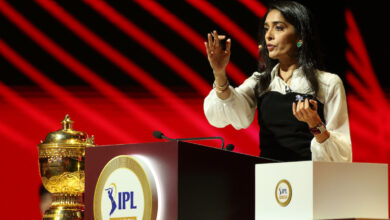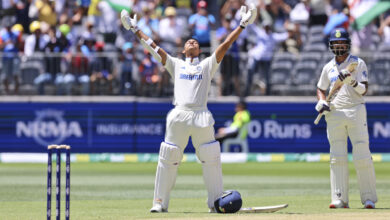Australian cricket conservative, Impact Player rule could be a game changer in T20s: Trent Woodhill

Mahendra Singh Dhoni called it a luxury to have and there can’t be a bigger endorsement of the Impact Player rule. Needless to say, I’m a big fan of it as we introduced it in the Big Bash League as “X Factor”. Although we were excited, the clubs did not embrace it as much as we would have liked and I believe much of it had to do with Australian cricket being conservative. And looking at the Impact Player rule in place at the Indian Premier League, I feel it would transform the tournament in a similar manner as the “Power Surge” rule. It is nothing but splitting the powerplay into two – four overs at the start and two after the 11th over – to eliminate any dull period in the middle overs. The Power Surge completely changed the outcome in a few matches and the Impact Player will do the same. When a team needs a power surge, they will use the Impact Player.
Compared to the ODI format, ever since it came into being and changed the cricketing landscape forever, T20 cricket has remained the same. Hence, we thought there is some scope for innovation and that is how X Factor and Power Surge came about. For nearly 20 years, T20 cricket remained the same, but the 50-over format has always evolved with time and continues to. And since all of those changes happened at the international level, every team had to embrace it. But in T20s, a lot of it is happening in the domestic T20 leagues. Initially, with these rule changes we brought in, there were sceptics as they just wanted to carry on with the game in the same way and eventually, it lasted only a couple of seasons in the BBL.
Say hello to the 1⃣st-ever Impact Player in the hory of the IPL! 👋@TusharD_96 is 🔛 the field, replacing Ambati Rayudu
Follow the match ▶️ https://t.co/61QLtsnj3J#TATAIPL | #GTvCSK | @ChennaiIPL pic.twitter.com/bkY7IF8Qpa
— IndianPremierLeague (@IPL) March 31, 2023
Now with the IPL, where the Impact Player has a wider scope than the X Factor rule, it could be a game changer in T20s. I’m really excited to see how it pans out and see how coaches like Stephen Fleming go about it because he is the sort of one who likes this kind of stuff. Same with Andy Flower and if they end up liking it, the Impact Player could travel around the world in other leagues as well. Moreover, it empowers and puts more responsibility on coaches.
It is what Power Surge and X Factor did to coaches in the BBL. During the middle of the game, we could see coaches and captains discussing what sort of a player could alter the course of the game. As a coach, you are suddenly made to plan and think a lot during the game. You are not thinking in hindsight at the end of the game, but you get a chance to make corrections in case you got it wrong with the selection at the toss.
I feel all these rule changes that are coming into the shortest format mean the players in the middle can hog the limelight even if they are there for only a brief period. Plus, as I said, it also brings the coaches into the play a lot more. It will also put them under enormous pressure during the game because the decision they make at a crucial juncture is going to be scrutinised a lot like in football, basketball, and rug. In every other sport, coaches are under enormous pressure, but in cricket, it is the captain. This will change that a bit. With Impact Player, hindsight won’t be your best friend anymore and the decision you make is vital as a coach.
There was another reason why the X Factor didn’t take off in the BBL. The feedback and the criticism we received about it was there was not enough talent depth to pick the sort of player who will be your X Factor. But in the IPL, there is no such issue because each team has not only enough squad depth but also players who can come off the bench and make a difference. Also, credit should be given to the IPL for widening the scope to use the Impact Player and giving the team the liberty to make full use of it allowing them to name the XI after the toss. With four overseas players allowed in the XI, teams can even choose three to start with and bring the fourth one depending on the match situation. It is all about using your imagination and picking the right ones.
The one other rule I would like to see in T20 leagues across the world is the Power Surge. From the outside, it will look like a needless innovation, but in BBL there was a need for it. January, pitches used to deteriorate and since the grounds are bigger than what you get in India, runs used to dip in the middle overs. The run-rate, in general, was a bit low between the 10th and 16th over and we wanted more action in that period and that is how Power Surge came about. Batting teams are anyway going to slog in the final four overs, so if they get two more overs with field restrictions, they would be tempted to take in those middle overs and take the momentum into the last four overs.
On slow pitches, if the ball gets soft it can get harder for batsmen. So when you have those two overs between 10-16th, it takes the pitch out of the equation as there are just two fielders outside the circle. Additionally, teams will have to mix up their bowling resources as well and need to bring their strike bowlers. And in a way, you are extending the slog overs as well. Plus, if you lose three wickets in the powerplay (6 overs), there is an 85 per cent chance of you losing the game. And if you take two overs away at the start, it gives the batting team a chance to make a comeback as well. In BBL we have seen teams going hard and ending up losing wickets which means, there is a balance between bat and ball.
Trent Woodhill is a high-performance consultant and introduced the X Factor and Power Surge rule to the Big Bash. He was also part of the group that came up with the concept of The Hundred, a tournament the ECB launched in 2021. Woodhill has also been a support staff of Royal Challengers Bangalore in the IPL. He spoke to Venkata Krishna B







